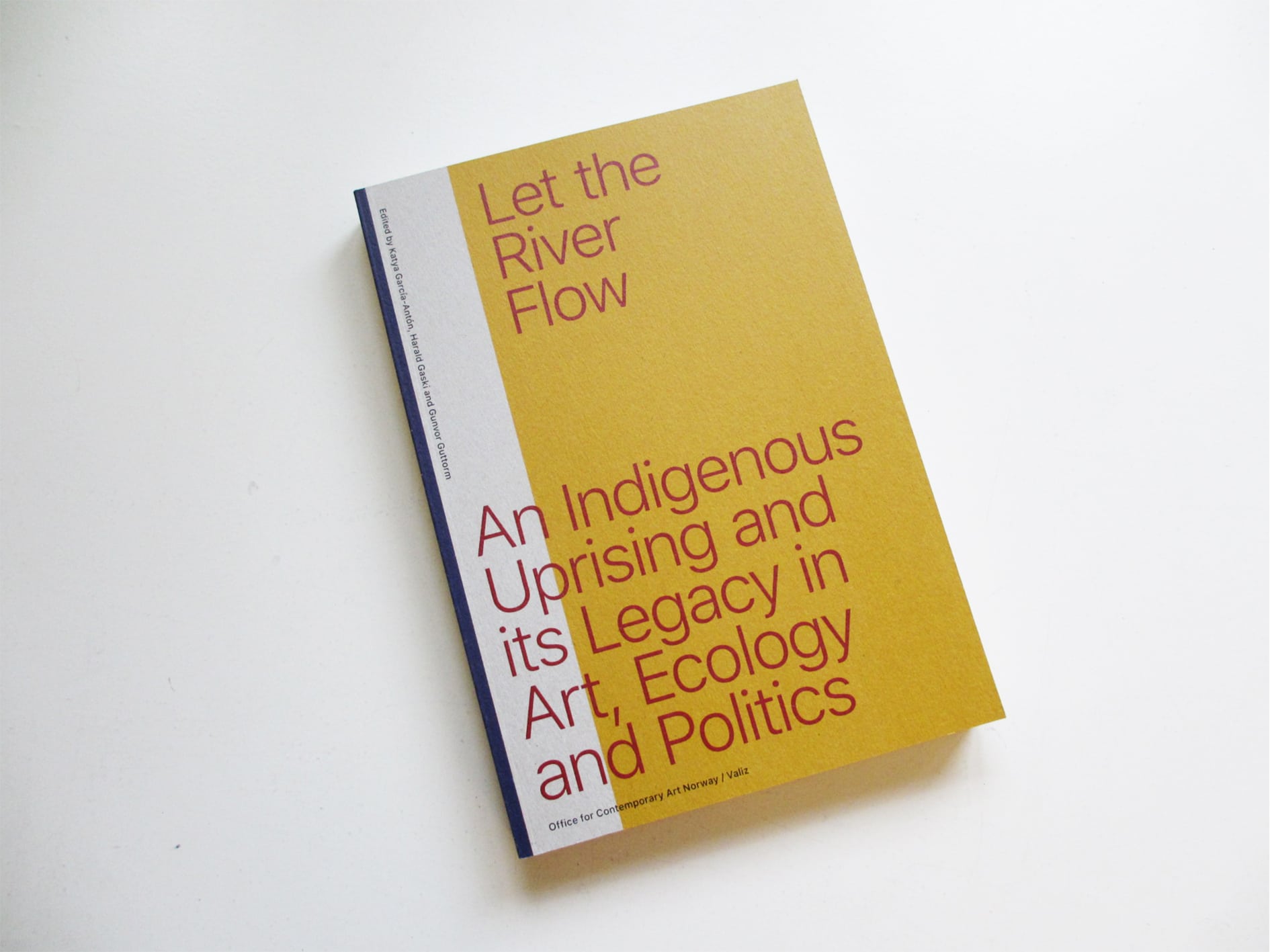The book edited by Katya García-Antón, Harald Gaski and Gunvor Guttorm belongs to a trilogy, published by the Office of Contemporary Art Norway. The book is based on experiences and work with the exhibition “Let the river Flow. The Sovereign Will and the making of a New Wordliness.” 1 The book contains contributions of various lengths written by Sámi and other Indigenous leaders, artists, musicians, political activists, Indigenous and non-Indigenous cultural workers and scholars. All of the writers are united in their goal of raising awareness about collective responsibility for the world, the wellbeing of the planet, and the people on it. Their contributions include several case studies of uprisings in Sápmi and other parts of Indigenous world.
- Let the River Flow. The Sovereign Will and the Making of a New Worldliness: News: OCA
The book contains 296 pages with widely varying text lengths – the shortest contribution is 3 pages long and the longest about 24 pages. The anthology is divided into 5 sections, each of which is titled in Sámi with title translations in English. The content of the first four sections is about collective remembering, claiming, naming, witnessing, appealing, celebrating, mourning, and sharing. The first section deals with reminiscences, reflections and analyses of the Áltá Action against the damming of the Áltá-Guovdageaidnu Waterway. This section functions as a starting point for comparisons and considerations about the legacy of Indigenous uprisings worldwide. The second section is about the corresponding historical events, happenings and actions both in Sápmi and in other parts of Indigenous world. The third section focuses on contemporary examples of Indigenous struggles to protect the lands and waters and the Indigenous way of life, as well as about custodianship of nature where people are seen as an inseparable part of nature. The fourth section is much about philosophy and aesthetics of Sámi cultural heritage in a broad understanding of Indigenous heritage which is passed down from generation to generation, as well as about anticolonial critique by Indigenous thinkers in both historical and contemporary times. The title of the fifth section of the book, “Gullat ja gulahallat: Listening and Communication,” conveys the fundamental value of Sámi collectivity which is based on the reciprocal nature of communication. The contributions in this section touch on the need to ponder and contemplate issues that do not seem to be obvious. Mostly, the contributions in this section are about understanding the concept of respect on Indigenous terms. This understanding is deeply rooted in traditional knowledge, in relationships, and in “irreplaceable values” – to borrow the expression from a contribution by a South Sámi writer Eva Maria Fjellheim.
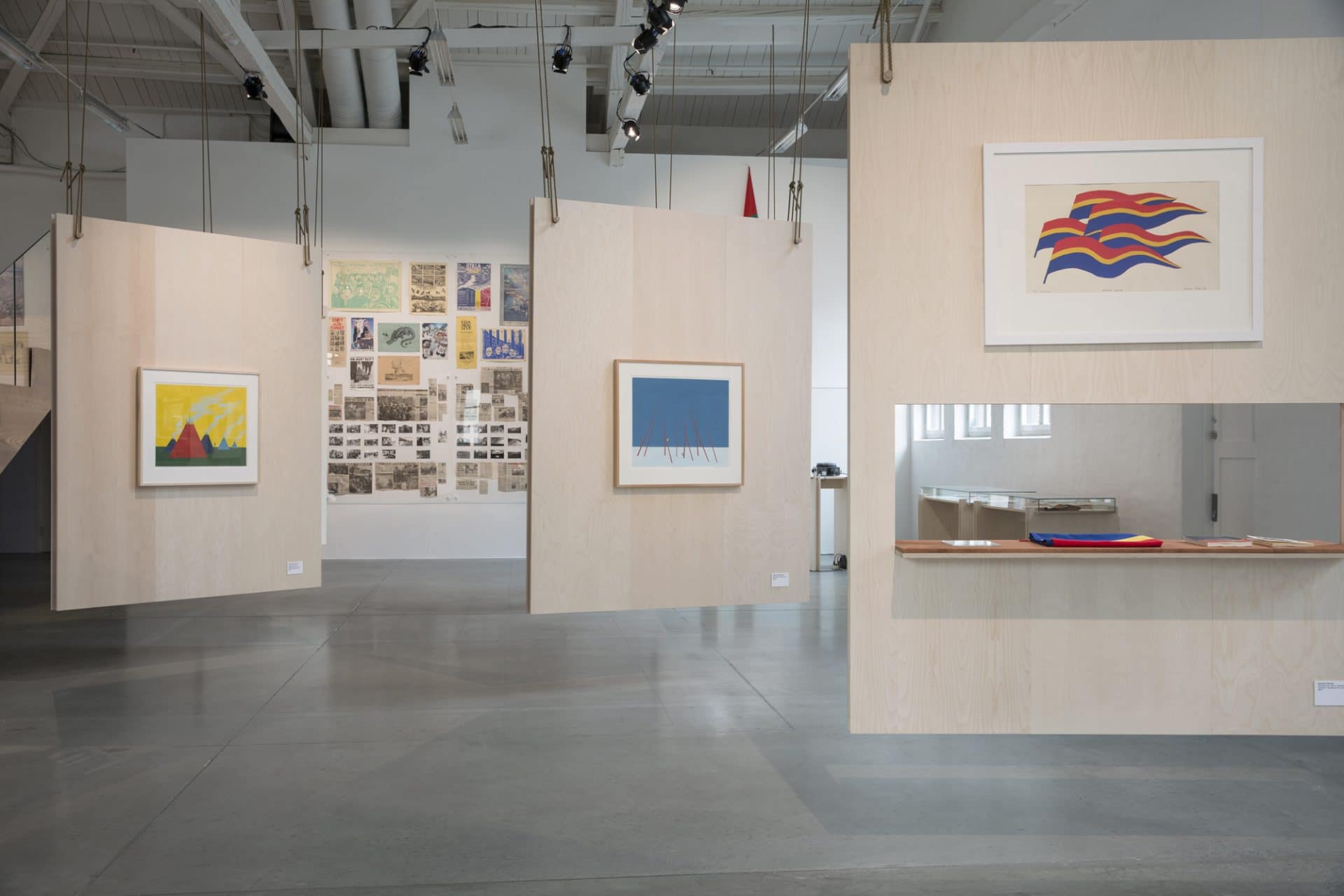
Within these sections, diverse cases display Indigenous peoples’ thoughts, reflections, contemplations, observations, achievements and failures in their endless struggles and actions to safeguard the natural world as the main foundation of Indigenous peoples’ life in the era of “extractivism”. A deliberately chosen Indigenous approach makes the book trustworthy: Indigenous writers are in the vast majority, with contributions by several Sámi wrtiers as well as Mapuche, Navajo Nation (Diné), Lakota, Dakota and Nakota People, and Anishinaabe perspectives; the structure of the book follows a distinct logic that is characteristic for narration and storytelling; Indigenous concepts are used throughout the book in almost all of the texts. It is worth mentioning, that despite of the fact that Sámi is a dynamic language dominated by the use of verbs in a countless variety of verb forms, four of the five section titles are based on substantives while the fifth one contains verbs. For a Sámi reader, the use of substantives might be interpreted as standpoints or statements which are not subject to change. This corresponds with a phenomenon of “the holding of one’s ground” as the opposite of displacement in Carolina Caycedo’s contribution. 2
- Carolina Caycedo, Dismembering the Collective Body, pp. 173-192.
The use of verbs in the title of the fifths section opens a venue to further discussions, implying that these conversations are to be continued. The texts in the book belong to several genres, such as essay, poetry, narration and reminiscent literature, thematic collection of pictures, song lyrics, joik (primarily dajahusat, meaning the text of the joik), pamphlet, political appeal, and literary analysis. A common feature for most of the contributions is a personal or emotional presentation that often demonstrates thoughts, feelings and reflections connected to a happening, an event or a literary/oral text. This personal touch makes the book appealing and interesting reading, which is thought provoking, leaving a trace in the reader’s mind and heart. Some of the contributions are based on historical facts, but most of the texts take personal lived experiences as the point of departure.
The book is dedicated to all who have fought for Sámi self-determination and sovereignty. The book pays respect to those who conducted hunger strikes in the late 1970s and the early 1980s, and to those who fearlessly supported them in the common struggle to resist the construction of the Áltá-Guovdageaidnu waterway. This commemoration does the book further credit.
The book is written and edited with genuine respect for Indigenous conceptualizations of the world and value systems. It is notable that place names always appear in the text with their Indigenous name, alongside the name given to places and territories by the majority societies. Sámi and other Indigenous language concepts, sayings and proverbs are presented as legitimate terms or aphorisms that deserve their place in an English language text, and not as a kind of exotic enhancement, but rather as expressions that add value and deeper meaning in the main text. These concepts are not entirely translatable into other languages, but they are meaningful and valuable explanations of Indigenous worldviews and value systems. The use of Indigenous concepts gives legitimacy to Indigenous language use in the writing. In turn, this strengthens and boosts the position of Indigenous languages, most of which are threatened. Some chosen examples of Indigenous conceptualisations are as follows: Ad mongen, Itfopil mongen “Laws of life, different classes of life” in Mapuchi, Jahki ii leat jagi viellja “No year is the other year’s brother” in Sámi, siida, ČSV, diida and numerous other foundational concepts in Sámi, Mni Woc’oni “Water of Life” in the Lakota, Dakota and Nakota traditions pointing to water as a source of life, not a resource.

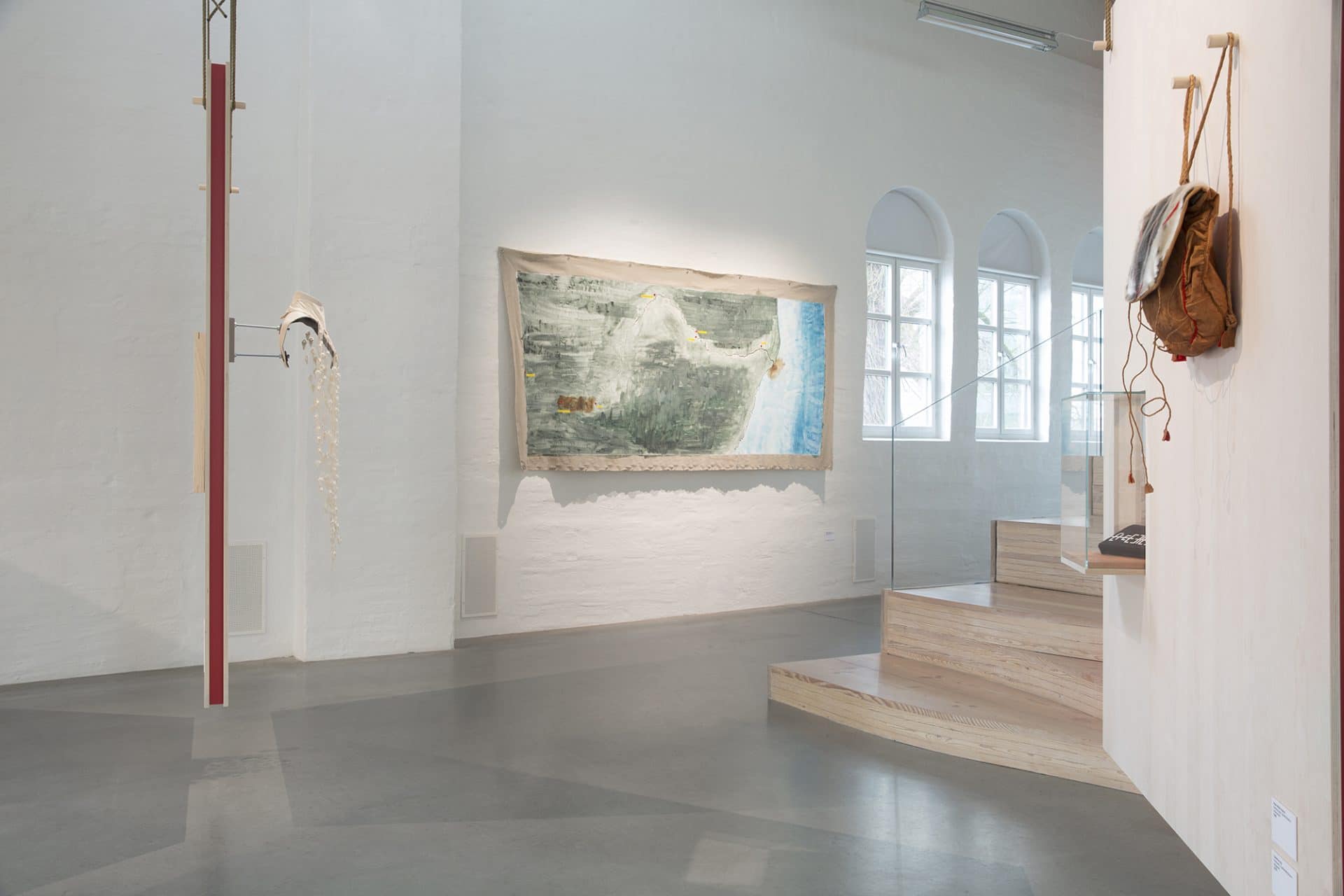


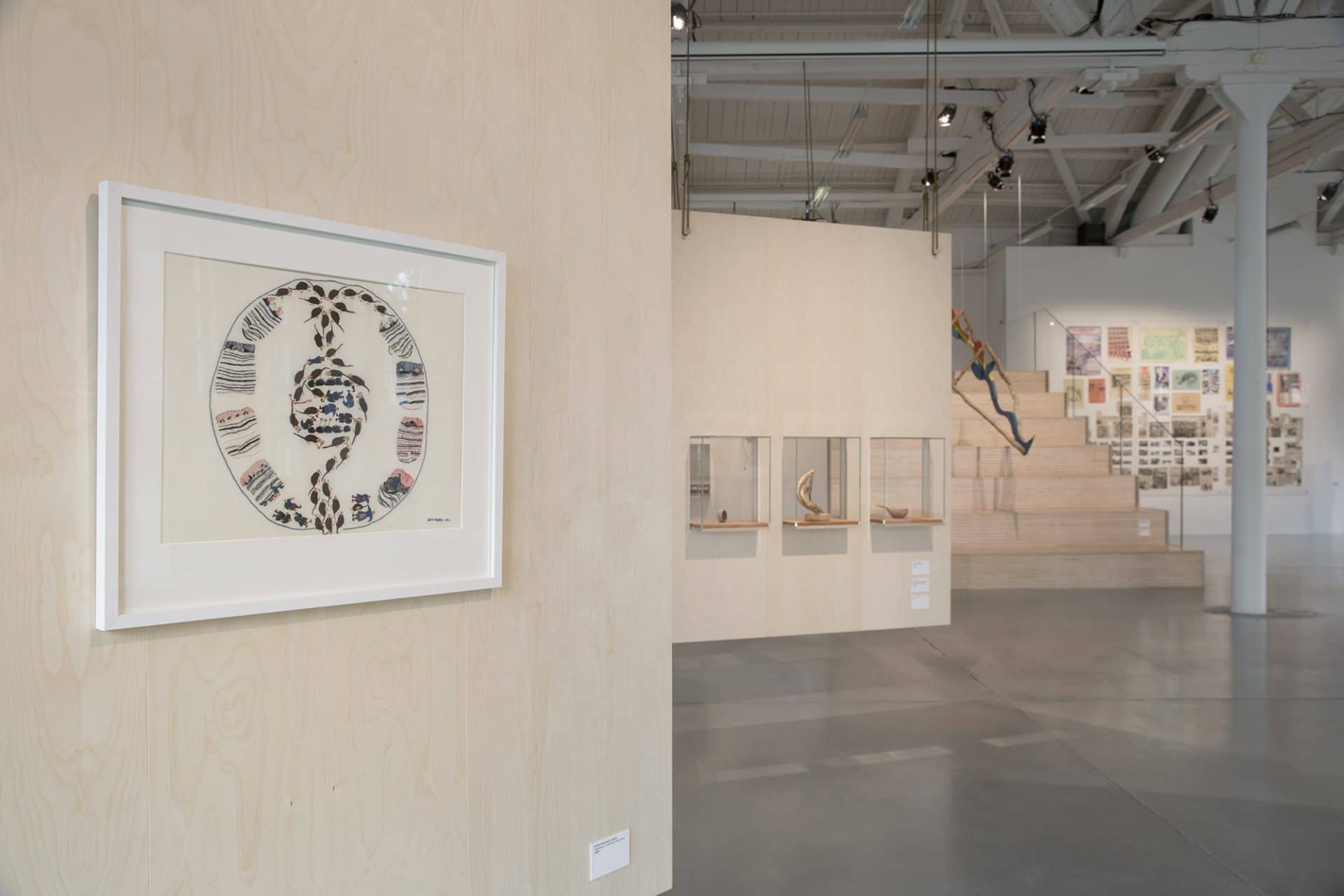
Contributions ask readers to reflect on the topics presented in the book, and to draw their own conclusions. The keyword for the entire book seems to be “Water.” This is probably not a coincidence as the book emerged from the exhibition that displayed the political, cultural and artistic movements and activities caused by the construction of a large dam in the Áltá-Guovdageaidnu Waterway on the Norwegian side of Sápmi. To quote various contributions in the book – water is territory, source of life, ancestor, and Indigenous right. A contribution by Daniela Catrileo seems to summarize the essence of the book as follows: “The present threat posed by the absence of water has become a cross-sectional dispute: not only is it a result of Indigenous nations and peoples decrying the injustice of how they are continuously dispossessed, but it is also a consequence of their various sacrifices leading to even more severe violations of the rights of other impoverished communities.” 3
- Daniela Catrileo, Ko ñi weychan by Sebastian Calfuqueo. An Act of Collective Resistance, pp. 133
The book sections can be read both chronologically one after another or in a random order without losing the sense of a cohesion. In a way, this is reminiscent of the Sámi joik, which is said to have “no beginning, no end.” This corresponds with the prayer by Chief Arvol Looking Horse who philosophically asserts that, “In the Sacred Hoop of Life, there is no ending and no beginning.” 4 The book structure and the selection of contributions into each section therefore seem to follow the logic of narration, prayer or joik, which is non-linear. By the end of the book one can feel the need to start from the beginning again, or to re-read some pieces in the middle, like following Buffy Sainte-Marie’s appeal in her song, to “Carry It On.” 5
- Chief Arvol Looking Horse, Standing Rock is Everywhere. One Year for Continued Efforts to Protect our Wateer and our Earth, p. 171.
- Buffy Sainte-Marie, Carry It On, pp. 285-287.
The commendable use of Indigenous concepts notwithstanding, the book employs some general terms from political and research discourses that could have been unpacked with greater attention. These include ecocide, genocide, and epistemicide, all of which appear in the text as manifestations of decisive political discourse rather than analytical concepts. Although these ideas are highly relevant for the topic of the book, there is a need to carefully and analytically reveal the meaning and the use of these concepts in relation to the multiple Indigenous political movements worldwide. In an analytical, research-based context, concepts would be explained as specific research tools that have been tested and evaluated. Consequently, these concepts would be presented in relation to a conceptual framework that shows an integrated way of looking at a particular phenomenon. In the case of this book, it would be a connection between ecosystem decline caused by human activities and the wellbeing and continuity of Indigenous peoples, humanity as a whole, and the Earth. Yet in the book, these terms seem to be intentionally used to display political activism that is highly critical of the use of natural resources for the sake of profit. Thus, the book itself takes a determined stance on activist environmental policies. A more analytical approach to the above-mentioned concepts might have strengthened the level of argumentation. On the other hand, the focus on political discourse in the book contributes to raising awareness about the struggle of Indigenous peoples around the globe. However this kind of essentialism should be avoided if the goal of the anthology is to remain relevant outside of political disputes.
The concept of green colonialism is another example of the co-opting of terms for political discourse. The term ‘green colonialism’ is introduced and extensively used in Eva Maria Fjellheim’s emotional and argumentatively strong petition to the Frostating Court of Appeal. 6 The phrase appears first in quotation marks, and is further used in an incontestable argument in reference to a claim by the president of the Sámi Parliament of Norway. The employment of this term in an appeal reasonably supports the purpose of the appeal as a genre. Yet, the concept as such and its use in the modern political rhetoric deserve to be scrutinized in a much more analytical way in order to exemplify and expand of the concept and its various use-cases, thus expressing in greater detail its meaning and connotations.
- The Frostating Court of Appeal (lagmannsrett) is one of Norway’s six courts of appeal. The court is based in Trondheim, and also has court premises in Ålesund, Molde and Kristiansund. The court has 19 judges. See: The Court - Frostating lagmannsrettFrostating lagmannsrett
The book is generally easy to read. The content skilfully occupies the reader’s attention. The language level, however, varies from a sophisticated, metaphorically rich English to less adept writing that could have benefited from further revision. This might be a result of the well-known challenges of writing in a foreign language and translating from various languages into English. In terms of the physical details of the book, the bookbinding is quite fragile as the paper sheets are bound together with glue. A more robust binding would better allow for continued use and reference over time. The use of various text colours on the book cover, in the table of contents, and in the bodies of the texts connects the book to the colourful Sámi duodji and other Indigenous art and craft traditions. Each chapter has its own colour: the introduction, the third chapter and appendices are in black, while the first chapter is in a deep crimson, the second in dark blue, the fourth in a light shade of brown, and the fifth in dark purple. Although the use of different colours makes each book section visually distinguishable, it is worth thinking about colour blind readers who might be challenged by the red text.
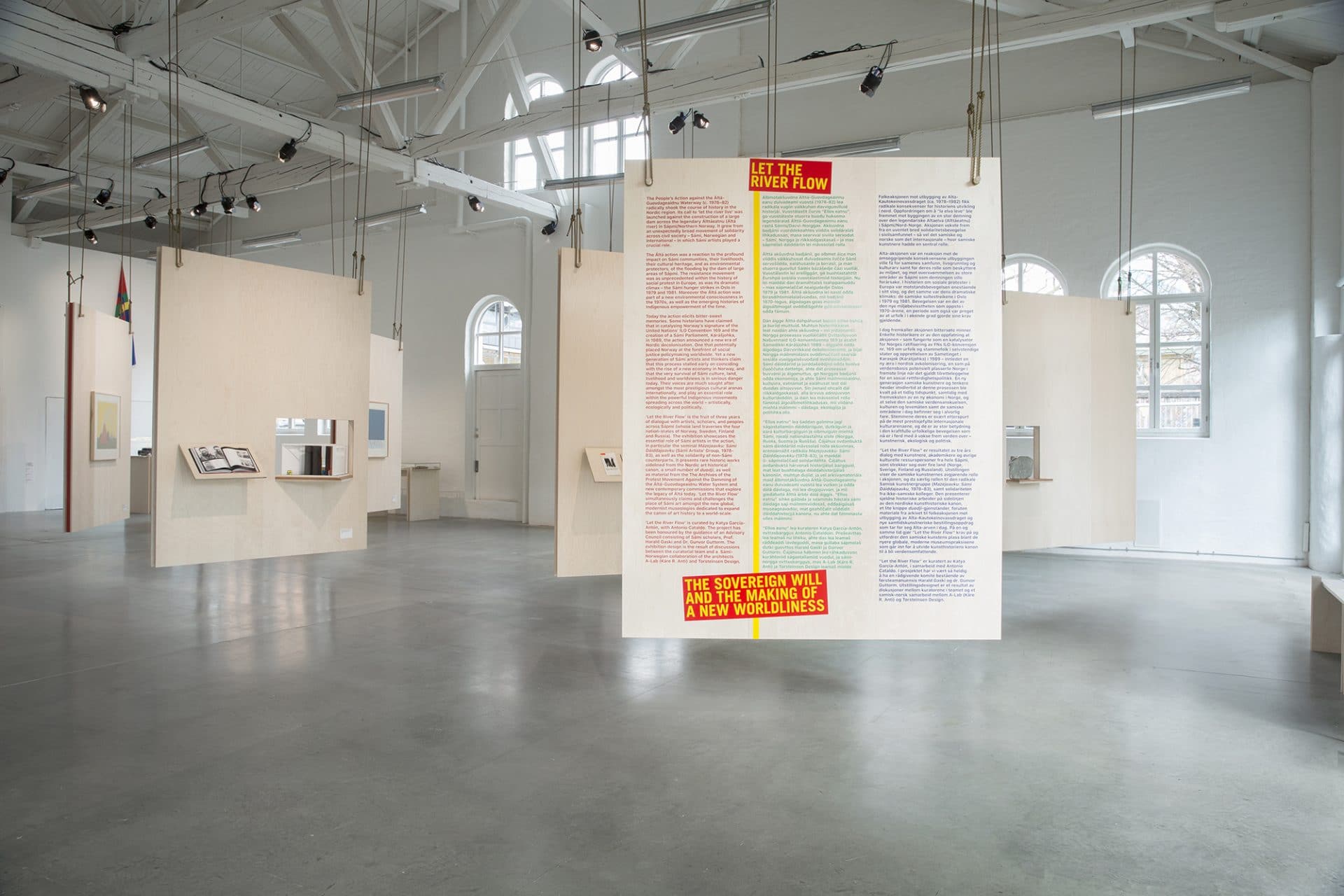
The book contains a wealth of illustrations that embellish and enrich the anthology as a whole. The historical photos appear both as black-and-white and as colour images. Clippings from newspapers can be read as they are, thus setting the topic of the main text into the factual situation of the described events and giving additional value to the main text. Reproductions of selected pieces of Indigenous artworks connect the text to the world of Indigenous aesthetics and philosophies. Special attention should be paid to an illustration in the piece “Whistle Quartet” by Raven Chacon, a composer, performer, and installation artist from Fort Defiance, Navajo Nation. 7 The illustration is a visual representation of a musical score that visually represents the music and rhythm of this performance created for four performers with dog whistles. This depiction is made with a traditional understanding of Indigenous music in mind and is rooted in traditional knowledge, philosophies, prayers, healing ceremonies and performative arts, acknowledging “the land, its mountains and its streams” (ibid., p.284).
- Raven Chacon, Whistle Quartet, pp. 281-284.
Ultimately, the book is an inspiring read for the general public, especially for those who work with Indigenous themes or are interested in Indigenous issues in cultural work, in literary studies, in museum exhibitions, in politics, and in ecological and Indigenous movements, to name only a few, and it could certainly be interesting for all regardless of age or professional qualifications. The book would benefit from a more analytical and research-based approach. As it stands, this publication might serve as a source for a case study that would analytically evaluate the material presented in this publication as a representation of Indigenous political activism, philosophies, aesthetic, logics and use of metaphor. The anthology centres Indigenous perspectives, knowledge, value systems and experiences, and recognizes the legacy of Indigenous uprisings in the arts, ecology and politics.
Dr. Jelena Porsanger is a Sámi scholar with a doctoral degree in the history of religion and Sámi research from the University of Tromsø (Norway) and a degree of Licentiate in philosophy from the University of Helsinki (Finland). She is currently Museum Manager of the Sámi museum in Karasjok –RiddoDuottarMuseat – Sámiid Vuorká-Dávvirat.
She was the vice-chancellor of Sámi University College (2011-2015), and previously she worked as researcher and leader of the Nordic Sámi research Institute in Kautokeino (Norway), as associate professor in the department of Sámi Studies at the University of Tromsø, and as lecturer and researcher at the University of Helsinki. She was the editor-in-chief (2007-2011) of Sámi diedalaš áigecála, a peer-reviewed Sámi language research journal. Her research interests are Indigenous methodologies, Indigenous religion, Sámi and Indigenous oral tradition, terminology and knowledge, source criticism. Her special areas of interest are indigenous research methodologies, traditional knowledge, research ethics, the empowerment of Sámi communities, capacity building, and the development and application of Indigenous approaches in research.


